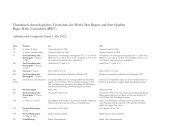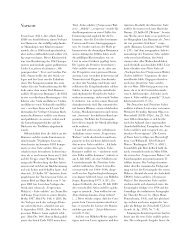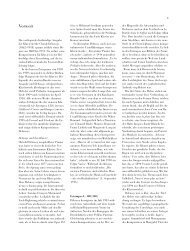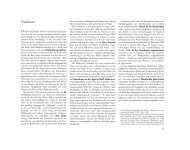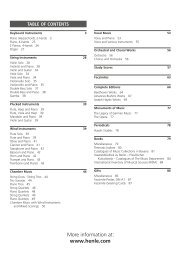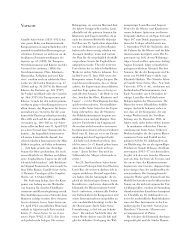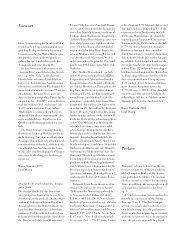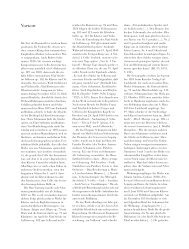Vorwort (PDF, 1698 KB) - Henle Verlag
Vorwort (PDF, 1698 KB) - Henle Verlag
Vorwort (PDF, 1698 KB) - Henle Verlag
Create successful ePaper yourself
Turn your PDF publications into a flip-book with our unique Google optimized e-Paper software.
XXVIII<br />
pieces into her repertoire. On 27 March<br />
1860 she played ten of them for the first time<br />
in public. Johannes Brahms likewise took<br />
the Davidsbündlertänze under his wing. He<br />
was probably the first to play the work in its<br />
entirety, namely on 15 March 1869 during<br />
a recital in Budapest with the singer Julius<br />
Stockhausen. Brahms also owned the autograph<br />
manuscript, located today among<br />
his posthumous papers in the archive of the<br />
Gesellschaft der Musikfreunde in Vienna.<br />
In addition to the eighteen numbers, it also<br />
contains a deleted dance in g minor that<br />
bears the number 6 of Book II, this dance<br />
is reproduced in our edition as an appendix<br />
to the opus 6. Pieces nos. I/7 and II/1 are<br />
dated in the autograph 11 and 7 September,<br />
respectively. This means that the eighteen<br />
numbers were not composed in the order in<br />
which they appear in the print; Schumann<br />
rearranged them on several occasions before<br />
finally settling on a definitive sequence.<br />
To ensure that the Davidsbündlertänze<br />
appeared in print as quickly as possible<br />
(they were evidently intended to be a sort of<br />
engagement present for Clara), Schumann<br />
did not even attempt to sell them to a prestigious<br />
music publisher, but had them issued<br />
by Friese, a Leipzig book dealer who also<br />
published his NEUE ZEITSCHRIFT FÜR MUSIK.<br />
He apparently paid for the engraving out of<br />
his own pocket and retained the rights to the<br />
publication. According to various entries in<br />
his diary, he read proofs for the first edition<br />
in October 1837 and again at the end of November.<br />
The print became available in late<br />
January 1838; Schumann curtly noted the<br />
event in his diary on 27 January: “Davidsbündlertänze<br />
finished.”<br />
The idea of having the work published by<br />
Friese quickly proved to be ill-conceived,<br />
and Schumann therefore attempted to sell<br />
the plates to a recognised music publishing<br />
house. On 5 November 1842 he offered<br />
the Davidsbündlertänze to Friedrich Hofmeister,<br />
explaining that they had been “issued<br />
by Friese and, as he is not a music<br />
dealer, they are still practically unknown,<br />
a state that will certainly change once a<br />
proper publisher has taken an interest in<br />
them, for these pieces in particular should<br />
find ready acceptance even in amateur circles.”<br />
Hofmeister declined the offer, however,<br />
and Schumann’s efforts to place the<br />
Davidsbündlertänze with other publishing<br />
houses also remained unsuccessful. It was<br />
not until 19 March 1850 that the Hamburg<br />
publisher Schuberth, probably impressed<br />
by the success of his edition of the Album<br />
for the Young (op. 68), agreed to include the<br />
Davidsbündlertänze in his catalogue. However,<br />
he proceeded on the assumption that<br />
“nothing needs be altered […] in the plates”<br />
(letter of 1 July 1850). Schumann made a<br />
number of changes anyway, but none was<br />
so far-reaching. This “second impression,”<br />
published in autumn 1850, was thus issued<br />
from the same plates that were used for the<br />
first edition. The production master was a<br />
copy of the first edition revised by Schumann<br />
himself.<br />
The present editor decided in favour of<br />
reproducing only the text of the 1850 version<br />
rather than attempting a conflation of<br />
the two versions. A detailed account of his<br />
reasoning and more precise information on<br />
the sources can be found in the Comments<br />
at the end of this volume, along with a list<br />
of discrepancies between the two editions of<br />
1838 and 1850. The most important of these<br />
discrepancies are referred to in footnotes.<br />
Toccata op. 7<br />
Robert Schumann’s Toccata op. 7 was several<br />
years in the making. According to an<br />
entry in the Projectenbuch and a note in the<br />
author’s personal copy of the first edition, a<br />
first version, headed Exercice, was written<br />
in 1830 while the composer was still studying<br />
law in Heidelberg. The work was then<br />
put aside, a fate shared by many of his compositions<br />
from the Heidelberg years. During<br />
these years Schumann devoted a great<br />
deal of time and effort to combining instru-



